Table of contents
The tomatillo ( Physalis philadelphica and Physalis ixocarpa ), also known as mountain eggplant, is a nightshade plant. The green fruit has a sour, fruity aroma and is used raw as the main ingredient in Mexican salsa verde. Organic quality is preferable.
Uses in the kitchen
What are tomatillos? Tomatillos are spherical, slightly flattened fruits with numerous small, round seeds in the flesh. They resemble unripe, green tomatoes . Although their name and appearance suggest a type of tomato, the tomatillo belongs to the genus Physalis . This also includes the related Cape gooseberry (often simply called Physalis), which is better known and more common.
In addition to the green tomatillo described here, there are other varieties (or types and shapes) that differ in size, taste and color. There are also purple and yellow fruits. The species Physalis ixocarpa and Physalis philadelphica are both known as tomatillo. There is no clear solution for species differentiation and classification: On the one hand, the names are used as synonyms, and on the other hand, the name Physalis ixocarpa describes the domesticated plant and Physalis philadelphica the wild plant. 1,2
The fruit is used raw and cooked as a vegetable, especially in Central American cuisine. Tomatillos, which are about the size of a plum or cherry tomato, have a firm consistency. When chewed, their bite is reminiscent of an apple. With their fruity note and sweet-sour taste, which tastes like a mixture of green apples and tomatoes, they are suitable for a variety of dishes. Their versatile use ranges from stews, soups, salads and curries to jams and desserts.
Like the physalis, tomatillos have a characteristic, papery shell. The shells are usually removed before consumption. However, they can also be used to make a broth that is suitable for seasoning rice or as a vegetable broth for risotto. The broth is also used to optimize the consistency of certain types of dough - for example for tamale, a traditional Mesoamerican dish.
Can you eat tomatillos raw? Although they are mostly grilled or cooked like eggplants and used in mixed vegetable dishes, tomatillos can also be eaten raw. 1 You can eat the entire fruit except for the papery calyx and the base of the stalk. Once you remove the calyx, the tomatillos can be sticky on the surface. It helps to rinse them briefly before eating. However, other parts of the plant should not be eaten as they can be poisonous. 16
Tomatillos are harvested at different stages of development, which affects their taste, color and intended use. Early-harvested fruit is used for what is known as salsa verde . The sour taste also goes well in salads, together with peppers, cucumber and corn, as well as bitter-tasting rocket and radicchio . Ripe fruit has a fruity, sweet note reminiscent of gooseberries, and is therefore suitable as a substitute for tomatoes. For example, the Mexican salsa pico de gallo, which usually consists of tomatoes, chili peppers, red onions, coriander leaves, lime juice and salt, can also be made with ripe, raw tomatillos for a green variant. Purple-ripening varieties are naturally slightly sweet, which makes them ideal for jams.
Latin American cuisine mainly uses unripe fruits to enhance the taste and appearance of salsas and vegetable stir-fries. In Mexican cuisine, they are often prepared together with chilis, as the two ingredients not only complement each other in terms of taste, but a combination also reduces the spiciness of the chilis.
Vegan recipe for tomatillo salad
Ingredients: 250 g tomatillo, 250 g cocktail tomatoes, 2 red onions, 2 cloves of garlic, 1 fresh jalapeño ( pickled also possible), 2 tbsp olive oil (or better cold-pressed rapeseed oil ), 2 tbsp freshly chopped coriander leaves, lime juice, sea salt .
Preparation: Wash the tomatillos and tomatoes and cut into small pieces. Peel the onions and garlic and dice finely. Wash the jalapeño, halve it, remove the seeds and chop it finely. Mix all the ingredients with oil and coriander leaves and season with lime juice and salt. This salad is also ideal as a salsa with tortilla chips.
Vegan recipes with tomatillo can be found under the note: " Recipes that have the most of this ingredient ".
| Not only vegans or vegetarians should read this: Vegans often eat unhealthily. Avoidable nutritional errors . |
Purchasing - Storage
In the USA, Mexico, Canada, and Central and South America, tomatillos can be bought raw or canned. 1 In Europe and the DA-CH region, apart from South American delicatessens, they can only be found in the vegetable section of larger, well-stocked supermarkets. Major retailers such as Migros, Coop, Edeka, Rewe, Spar, Aldi, Lidl, Denner, Hofer and Billa rarely stock the fruit and if they do, then only as special offers. Some supermarkets sell tomatillos preserved in salt water or the well-known, ready-made salsa verde. Organic quality can be found in organic supermarkets such as Alnatura and Denn's Biomarkt . Alternatively, tomatillos can be ordered online.
When buying fresh fruit, pay attention to how firm it is to the touch and whether it has a strong color. Aromatic tomatillos are not much bigger than a golf ball. The thin calyx surrounding the fruit should be relatively fresh and not completely dried out.
Tomatillos are mainly imported from tropical and subtropical regions. 1 Mexico, where the fruit is grown all year round. is its largest producer. 10,17 However, tomatillos are heat-loving plants, so their main season is mainly in the summer months from July to September. is. 17
The availability of Tomatillo varies depending on the size of the store, catchment area, etc. Our recorded food prices for the DA-CH countries can be found above under the ingredient image - and by clicking you can see their development at various suppliers.
Found in the wild
While the species Physalis ixocarpa is only found in a domesticated form, Physalis philadelphica is the wild form. 1,3 Physalis philadelphica is described as a variant (var. philadelphica ) of the bladdernut ( Physalis angulata ). 4 Physalis ixocarpa is also classified as a subspecies (subsp. ixocarpa ) of the wild-growing Physalis philadelphica . 5 The two species are also often used as synonyms. 1,2
Wild tomatillo plants are mostly found in Central America and Mexico, their original home. There is also evidence of wild specimens in regions outside their natural range, such as California in the USA or Guatemala and Nicaragua. 1,3 They often grow near agricultural areas with tomatoes, corn and cucurbits. 6
Storage tips
Ripe, undamaged tomatillos can be stored for up to a week at room temperature. Longer storage is possible at 5-10 °C. However, cold damage begins to appear after 2-3 weeks at 5 °C and after 3-4 weeks at 10 °C.
To extend the shelf life, the fruit can also be dried gently. 1 They are only suitable for freezing to a limited extent. Similar to tomatoes, the high water content means that the water expands when frozen and destroys the cell walls. Frozen tomatillos are therefore no longer suitable for eating raw, but processing them in cooked dishes is not a problem.
Ingredients - Nutritional values - Calories
The raw tomatillo fruit consists of approximately 92% water 1.10, which makes it very low in calories with an energy content of 32 kcal/100g. The macronutrients are divided into 1 g fat, 5.8 g carbohydrates and 0.96 g protein. 7
Tomatillos contain 12 mg of vitamin C (ascorbic acid), which is 15% of the daily requirement. The same amount can be found in artichokes and cranberries . Sea buckthorn berries (567 mg/100g), black currants (181 mg/100g) and sweet peppers (128 mg/100g) are particularly rich in vitamin C. 7
The potassium content of the fruit is 268 mg/100g. This corresponds to 13% of the daily requirement. This value is comparable with raw apricots (259 mg/100g) and Galia melon (309 mg/100g). Spinach offers twice as much potassium at 558 mg/100g. The foods that contain the most potassium are often spices or herbs ( eg dried coriander leaves : 4,466 mg/100g). However, we only eat small amounts of these. 7
The raw tomatillo contains 10 µg of vitamin K per 100 g, which is 13% of the daily requirement. Carrots (13 µg), grapes (15 µg) and sour cherries (11 µg) offer a comparable amount. Swiss chard with 830 µg/100g and kale with 705 µg/100g are particularly rich sources of vitamin K. 7
You can find all the ingredients of Tomatillo, the coverage of the daily requirement and comparison values with other ingredients in our nutrient tables. In the article Nutrients explained you will get a detailed insight into the topic.
Effects on health
The health effects of Tomatillo are due to the secondary plant substances it contains.Secondary plant substances
Our article on secondary plant substances provides an overview of the classification of substance groups, their occurrence in foods and possible effects on humans.
The Tomatillo contains the following secondary plant substances: 1,8,9
- Isoprenoids: monoterpenes (beta-pinene and 3-carene); sesquiterpenes (beta-caryophyllene, beta-elemene, germacrene D); triterpenes: steroid lactones (withanolides, physaline), saponins; tetraterpenes: carotenoids (carotenes: beta-carotene, alpha-carotene, lutein; xanthophylls: zeaxanthin)
- Alkaloids: Steroid alkaloids (tomatidine)
- Polyphenols: Phenolic acids: Hydroxybenzoic acids (gallic acid); Flavonoids: flavanols (catechin), flavonols (quercetin), anthocyanins (pelargonidin-3-glucoside)
- Other organic compounds: aldehydes (decanal, hexanal, nonanal); alcohols (hexanol)
However, it should be noted that the composition of the secondary plant substances in the tomatillo can vary depending on the variety, time of harvest and growing conditions. Therefore, quantities are only of limited use and should only be understood roughly.
The terpenes present, together with the other secondary plant substances, give the tomatillos their aroma and taste. In a study, fresh P. philadelphica and P. ixocarpa species from Puebla (Mexico) showed rather low concentrations of the carotenoids beta-carotene (2 and 21 µg/100mg, respectively) and lutein (12 and 1 µg/100mg, respectively). 1 The antioxidant activity of the tomatillo is related to the presence of polyphenols and ascorbic acid. The physalins and alkaloids contained in the tomatillos also make a contribution. These antioxidant compounds are able to intercept free radicals and thus protect against oxidative stress and associated (chronic) diseases such as cancer, Alzheimer's or diabetes. 9
Tomatillos have anti-inflammatory, antimicrobial, antipyretic and immunosuppressive properties, which are attributed to the withanolides. These compounds show promising effects in the fight against cancer, especially in connection with their antitumor activity. The withanolides extracted from the tomatillo have been shown to be cytotoxic to cell lines of kidney cancer and melanoma. Studies show that withanolides induce quinone reductase, which is associated with the prevention of tumor formation. 10
Physalines, which are mainly found in the genus Physalis, have been shown to have antitumor and antimicrobial effects. 9,10
Dangers - Intolerances - Side effects
Are tomatillos poisonous? The fruits of the tomatillo can be eaten raw without any concerns. 1 Eating other parts of the plant is not recommended, as these can be poisonous under certain circumstances and lead to stomach cramps, vomiting and other symptoms of poisoning. 16 Allergies to tomatillos are rare. 11
Risk of confusion
Green tomatillos can be confused with unripe, green tomatoes. The confusion is based both on their visual appearance and on the misleading name 'tomate verde' (translated as green tomato). The glycoalkaloid tomatine (non-specifically referred to simply as solanine) contained in unripe tomatoes is considered harmful to health. 12
Folk medicine - natural medicine
The fruits are often used in traditional Mexican folk medicine to relieve fever, cough, tonsillitis, gastrointestinal complaints or to treat diabetes. 1.9
Ecological Footprint - Animal Welfare
The ecological footprint of a food depends on various factors. The type of agricultural production (conventional vs. organic), seasonal, regional, domestic production or import by truck, ship or plane, different types of packaging and whether the goods are fresh or frozen play a decisive role. 13
According to the website healabel, the carbon footprint of tomatillos is 1.1 kg CO 2 eq/kg. 14 Despite extensive research, we are not aware of any comparative values. It should also be noted that we do not have any information on the breakdown of the carbon footprint. Since tomatillos are mainly grown in subtropical and tropical areas, they are imported fruits that require long transport routes. 1,17 The value can therefore be significantly higher due to transport-related emissions. For the ingredient pineapple, we explain the influence of different means of transport such as ships or aircraft on the size of the footprint.
For comparison: seasonal, regional tomatoes, which require similar growing conditions, have an average CO 2 footprint of 0.3 kg CO 2 eq/kg. 13
The water footprint for producing 1 kg of tomatillo is 214 liters and is therefore low. 14 Other nightshade crops show similar values: potatoes require 287 l/kg, eggplants 362 l/kg and tomatoes 214 l/kg. 15
For detailed explanations of various sustainability indicators (such as ecological footprint, CO2 footprint, water footprint), see our article: What does the ecological footprint mean?
Worldwide occurrence - cultivation
The tomatillo originally comes from Mexico and Guatemala. 1,10 The plants grow in tropical and subtropical regions all over the world, especially in countries on the American continent. 1 The largest importer of the fruit is the USA. 10
Cultivation - Harvest
seeds can be ordered online: prefer organic seeds. Growing your own plants is easy with a heated greenhouse or in a location in warm climates.
Tomatillos are annual plants that reach a height of 60 to 120 cm. 10 They thrive best at low altitudes at 18 to 25 °C on slightly acidic soils in regions with an annual rainfall of 15 to 120 cm. The life cycle of the tomatillo plant is short (3-4 months). The plant needs about 12 to 14 weeks to grow. After this time, the fruits are ready to be harvested. 1
The leaves of the tomatillo are egg-shaped with a pointed end and, in some varieties, wavy at the edge. They are about 3 cm wide and 6 cm long. The flowers sprout individually in the branches of the stem. They consist of five yellow petals with dark spots that are about 2 cm long, and five green, bell-shaped sepals. 1
As the plant grows and flowers, the calyx enlarges to cover the developing fruit. 1 The calyx or fruit shell serves to support the spread of the seeds and provides protection from environmental influences such as pests (insects and birds), diseases and extreme weather conditions such as heavy rain, hail, storms or large temperature fluctuations. 1, 10
Depending on the variety, tomatillos are either green or purple. Varieties that produce purple fruits include 'Purple Coban', 'Purple de Milpa', 'Purple Hybrid' and 'Plum Jam'. The round fruits, which have a diameter of 2.5 to 6 cm, can be harvested at different stages of development (ripe or unripe). For commercial purposes, harvesting usually takes place when they have reached their maximum size. At this point, the calyx is completely filled or, in some cases, broken. 1
There are two species of Physalis that produce tomatillos: Physalis ixocarpa, the domesticated variety used for cultivation, and Physalis philadelphica, which is the wild form. 1
The plants are grown by direct sowing or transplanting. Direct sowing outdoors is only possible when there is no risk of frost and the outside temperature is more than 18 °C. The seeds then usually begin to germinate after 7-10 days and the sprouts begin to grow. The first flower buds form after about 3-4 weeks. Another 8 weeks pass before the fruits reach their maximum size. 1
Alternatively, the seeds can be grown under controlled conditions. The seedlings can then be planted outdoors when the outside temperature is suitable. This method allows the plants to be planted when the outside temperature is below 18 °C, which enables an earlier harvest. 1
Disease or pest infestation of plants manifests itself through wilting, poor growth, discoloration, root rot and the death of the plants. 1
Growing your own
You can also try growing tomatillos at home. This works particularly well in warm climates. Alternatively, you can use a heated greenhouse. A bed in the garden or a pot or tub are also suitable for growing your own. Seeds can be bought online or sometimes in a garden center. When it comes to seeds, give preference to organic quality.
The plants can be grown on the windowsill. To do this, plant the seeds individually in containers with nutrient-poor soil from February onwards. The seed depth should be around 0.5 cm. Make sure that the seeds are always well moistened. The seedlings need temperatures of 20 to 25 °C. As tomatillo plants are sensitive to frost, you should wait until the last frost in mid-May before planting them outdoors. For optimal pollination, it is recommended to have at least two plants and to keep enough space between them. The first ripe fruits can be harvested from September onwards, as soon as the flower calyx splits open. 16
Further information
The tomatillo ( Physalis philadelphica ) belongs to the plant genus of the Physalis, which includes around 85 species. The members of this genus can be distinguished by their calyx, which surrounds the fruit during the development phase. The genus Physalis is part of the nightshade family (Solanaceae), which also includes more well-known crops such as the tomato ( Solanum lycopersicum ), pepper ( Capsicum annuum ) and potato ( Solanum tuberosum ). 10
Relatives of the tomatillo include the Cape gooseberry ( Physalis peruviana ), the pineapple cherry ( Physalis pruinosa ) and the Chinese lantern flower ( Physalis alkekengi ). The close relationship to the Cape gooseberry and the pineapple cherry allows for confusion. However, these species are also edible when ripe. 10
Alternative names
The tomatillo also has the names mountain eggplant, blue physalis, Mexican pod tomato and Mexican bladder cherry. "The" tomatillo is also common. The species Physalis philadelphica is called strawberry tomato. 16
In English, the fruit is known as tomatillo, jamberry, Mexican husk tomato or Mayan husk tomato. In Mexico, the fruit has many names, including tomate, tomate verde, tomate cascara, tomate milpero, fresadillas, tomate de capote, tomate milpa and miltomate. 1
The term tomatillo is derived from the Spanish diminutive for tomato, which in turn comes from the word "tomatl" from the Aztec language Nahuatl. 1
Bibliography - 17 Sources (Link to the evidence)
| 1. | González-Pérez JE, Guerrero-Beltrán JÁ. Tomatillo or husk tomato ( Physalis philadelphica and Physalis ixocarpa ): A review. Scientia Horticulturae. 2021;288:110306. |
| 2. | The Jepson Herbarium. University of California, Berkeley. Jepson eFlora: Physalis philadelphica. 2024. |
| 3. | Robledo-Torres V, Ramírez-Godina F et al. Development of tomatillo (Physalis ixocarpa Brot.) autotetraploids and their chromosome and phenotypic characterization. Breed Sci. 2011;61(3):288–293. |
| 4. | Royal Botanic Gardens Kew. Plants of the World Online. Physalis philadelphica Lam. |
| 5. | Royal Botanic Gardens Kew. Plants of the world online. Physalis ixocarpa Brot. ex Hornem. |
| 6. | Díaz-Pérez JC, Phatak SC et al. Root Zone Temperature, Plant Growth, and Fruit Yield of Tomatillo as Affected by Plastic Film Mulch. HortScience. 2005;40(5):1312–1319. |
| 7. | USDA (United States Department of Agriculture). Nährwerttabellen. |
| 8. | Drost-Karbowska K, Ellnain-Wojtaszek M et al. Phytochemical investigation of the tomatillo fruit (Physalis ixocarpa Brot., Solanaceae). Acta Societatis Botanicorum Poloniae. 1993;62(3–4):155–159. |
| 9. | Shamsolshoara N, Miri SM, Badi HN. Arginine and Folic Acid Improve Metabolites Content of Tomatillo (Physalis philadelphica) Fruit. Russ J Plant Physiol. Februar 2024;70(9):211. |
| 10. | Shenstone E, Lippman Z, Van Eck J. A review of nutritional properties and health benefits of Physalis species. Plant Foods Hum Nutr. 2020;75(3):316–325. |
| 11. | Su S, Samstein M et al. M302 TOMATILLO ALLERGY: A UNIQUE CASE. Annals of Allergy, Asthma & Immunology. 2020;125(5, Supplement):S97–S98. |
| 12. | Weiss C. Glykoalkaloide in Kartoffeln und Tomaten. Ernährungs Umschau. 2007;8:474-477. |
| 13. | Reinhardt G, Gärtner S, Wagner T. Ökologische Fussabdrücke von Lebensmitteln und Gerichten in Deutschland. Institut für Energie - und Umweltforschung Heidelberg. 2020. |
| 14. | Healabel com: Tomatillo Benefits and Side Effects. 2023. |
| 15. | Mekonnen MM, Hoekstra AY. The green, blue and grey water footprint of crops and derived crop products. Hydrol Earth Syst Sci. 25. Mai 2011;15(5):1577–1600. |
| 16. | plantura garden: Physalis: Sorten, Ernte & Vermehrung. 2024. |
| 17. | foodprint org: Tomatillos. 2024. |

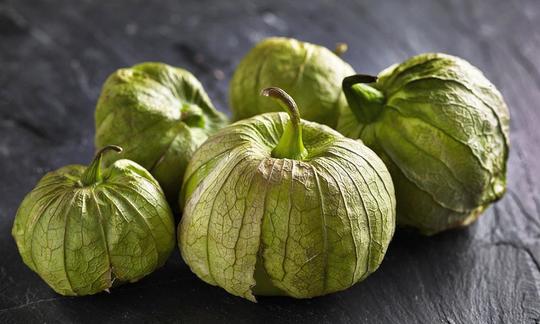

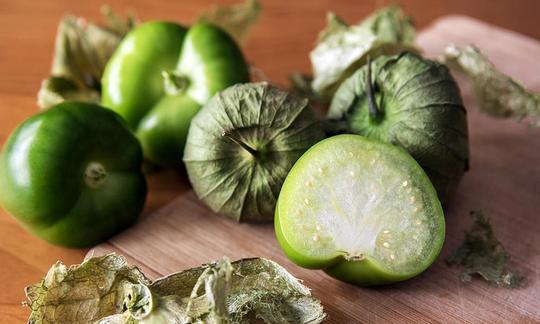

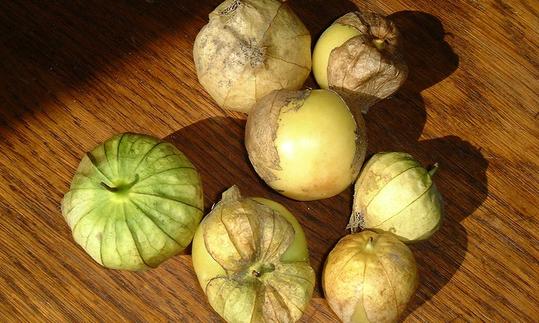

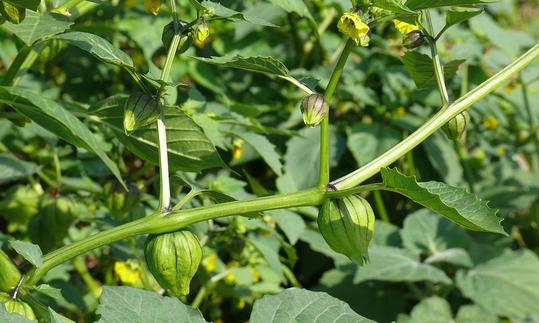

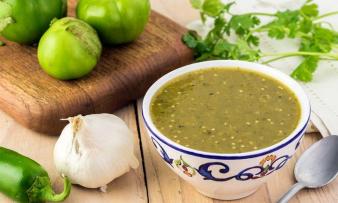





Comments